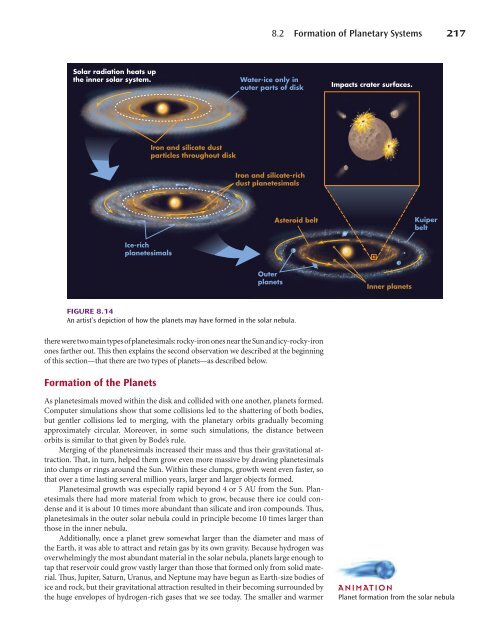Chapter 8
Chapter 8
Chapter 8
You also want an ePaper? Increase the reach of your titles
YUMPU automatically turns print PDFs into web optimized ePapers that Google loves.
Solar radiation heats up<br />
the inner solar system.<br />
Ice-rich<br />
planetesimals<br />
FIGURE 8.14<br />
An artist’s depiction of how the planets may have formed in the solar nebula.<br />
there were two main types of planetesimals: rocky-iron ones near the Sun and icy-rocky-iron<br />
ones farther out. Th is then explains the second observation we described at the beginning<br />
of this section—that there are two types of planets—as described below.<br />
Formation of the Planets<br />
Iron and silicate dust<br />
particles throughout disk<br />
As planetesimals moved within the disk and collided with one another, planets formed.<br />
Computer simulations show that some collisions led to the shattering of both bodies,<br />
but gentler collisions led to merging, with the planetary orbits gradually becoming<br />
approximately circular. Moreover, in some such simulations, the distance between<br />
orbits is similar to that given by Bode’s rule.<br />
Merging of the planetesimals increased their mass and thus their gravitational attraction.<br />
Th at, in turn, helped them grow even more massive by drawing planetesimals<br />
into clumps or rings around the Sun. Within these clumps, growth went even faster, so<br />
that over a time lasting several million years, larger and larger objects formed.<br />
Planetesimal growth was especially rapid beyond 4 or 5 AU from the Sun. Planetesimals<br />
there had more material from which to grow, because there ice could condense<br />
and it is about 10 times more abundant than silicate and iron compounds. Th us,<br />
planetesimals in the outer solar nebula could in principle become 10 times larger than<br />
those in the inner nebula.<br />
Additionally, once a planet grew somewhat larger than the diameter and mass of<br />
the Earth, it was able to attract and retain gas by its own gravity. Because hydrogen was<br />
overwhelmingly the most abundant material in the solar nebula, planets large enough to<br />
tap that reservoir could grow vastly larger than those that formed only from solid material.<br />
Th us, Jupiter, Saturn, Uranus, and Neptune may have begun as Earth-size bodies of<br />
ice and rock, but their gravitational attraction resulted in their becoming surrounded by<br />
the huge envelopes of hydrogen-rich gases that we see today. Th e smaller and warmer<br />
8.2 Formation of Planetary Systems 217<br />
Water-ice only in<br />
outer parts of disk<br />
Iron and silicate-rich<br />
dust planetesimals<br />
Outer<br />
planets<br />
Asteroid belt<br />
Impacts crater surfaces.<br />
Inner planets<br />
Kuiper<br />
belt<br />
ANIMATION<br />
Planet formation from the solar nebula<br />
arn12176_ch08.indd 217 7/30/09 2:14:39 PM

















